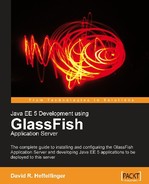Book Description
"The complete guide to installing and configuring the GlassFish Application Server and developing Java EE 5 applications to be deployed to this server
Concise guide covering all major aspects of Java EE 5 development
Uses the enterprise open-source GlassFish application server
Explains GlassFish installation and configuration
Covers all major Java EE 5 APIs
In Detail
GlassFish is a free, open-source Java EE 5-compliant application server that is quickly gaining massive popularity.
This book explains GlassFish installation and configuration, and then moves on to Java EE 5 application development, covering all major Java EE 5 APIs.
Chapter 1 provides an overview of Glassfish, including how to install it, configure it, and verify the installation.
Chapter 2 covers how to develop server-side web applications using the Servlet API.
Chapter 3 explains how to develop web applications using JavaServer Pages (JSPs), including how to develop and use JSP custom tags
Chapter 4 discusses how to develop Java EE applications that interact with a relational database system through the Java Persistence API (JPA) and through the Java Database Connectivity API (JDBC).
Chapter 5 explains how to use the JSP Standard Tag Library (JSTL) when developing JavaServer Pages
Chapter 6 covers how to develop applications using the JavaServer Faces (JSF) component framework to build web applications.
Chapter 7 explains how to develop messaging applications though the Java Messaging Service (JMS) API.
Chapter 8 covers securing J2EE applications through the Java Authentication and Authorization Service (JAAS).
Chapter 9 discusses how to develop Enterprise Java Beans that adhere to the EJB 3 specification.
Chapter 10 explains how to develop and deploy web services that conform to the JAX-WS 2.1 specification.
Chapter 11 covers frameworks that build on top of the Java EE 5 specification, including Seam, Facelets, and Ajax4Jsf.
The appendices cover some of the advanced features of the GlassFish server.
This book is a Developer’s Guide, covering the ins and outs of developing Java EE 5 applications deployed to the standards-compliant, high performance GlassFish application server.
"Table of Contents
- Java EE 5 Development using GlassFish Application Server
- Credits
- About the Author
- About the Reviewers
- Preface
- 1. Getting Started with GlassFish
- 2. Servlet Development and Deployment
- 3. JavaServer Pages
- 4. Database Connectivity
- 5. JSP Standard Tag Library
- 6. JavaServer Faces
- Developing Our First JSF Application
- Custom Data Validation
- Customizing JSF's Default Messages
- Integrating JSF and JPA
- JSF Core Components
- <f:actionListener>
- <f:attribute>
- <f:convertDateTime>
- <f:convertNumber>
- <f:converter>
- <f:facet>
- <f:loadBundle>
- <f:param>
- <f:phaseListener>
- <f:selectItem>
- <f:selectItems>
- <f:setPropertyActionListener>
- <f:subview>
- <f:validateDoubleRange>
- <f:validateLength>
- <f:validateLongRange>
- <f:validator>
- <f:valueChangeListener>
- <f:verbatim>
- <f:view>
- JSF HTML Components
- <h:column>
- <h:commandButton>
- <h:commandLink>
- <h:dataTable>
- <h:form>
- <h:graphicImage>
- <h:inputHidden>
- <h:inputSecret>
- <h:inputText>
- <h:inputTextarea>
- <h:message>
- <h:messages>
- <h:outputFormat>
- <h:outputLabel>
- <h:outputLink>
- <h:outputText>
- <h:panelGrid>
- <h:panelGroup>
- <h:selectBooleanCheckbox>
- <h:selectManyCheckbox>
- <h:selectManyListbox>
- <h:selectManyMenu>
- <h:selectOneListbox>
- <h:selectOneMenu>
- <h:selectOneRadio>
- Additional JSF Tag Libraries
- JSF Core Components
- Summary
- 7. Java Messaging Service
- 8. Security
- 9. Enterprise JavaBeans
- 10. Web Services
- 11. Beyond Java EE
- A. Sending Email from Java EE Applications
- B. IDE Integration
